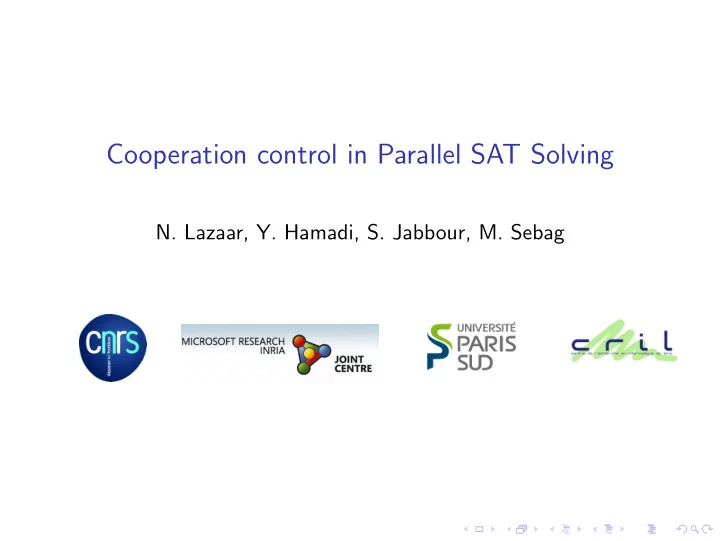

Cooperation control in Parallel SAT Solving N. Lazaar, Y. Hamadi, S. Jabbour, M. Sebag
Parallel SAT Solving Decentralized resolution ◮ Each core: conflict-directed clause learning ◮ Cooperation: each core sends the learned clauses to other cores ◮ Why? additional clauses help pruning the search space. Previous work Hamadi et al. 09 ◮ Controlling the length of the shared clauses (TCP/IP congestion avoidance, additive increase multiplicative decrease)
Limitations Does not scale up when the number of cores increases. Position of the problem ◮ Dynamically control the topology of the network ◮ This paper: density ρ is fixed
BESS Bandit Ensemble for parallel SAT Solving Core tasks ◮ Design the reward ◮ Adjust the decision schedule wrt internal SAT schedule BESS structure ◮ Each receiver core ◮ selects n emitter cores n = 1 / 2 # cores
Designing the reward of an emitter core Reward(emitter): sum of reward(shared clauses) I. Global clause rewards ◮ Size-based: clause of length s removes 2 N − s instances r ( c ) = − log 1 − 2 − s ◮ Literal-block distance each literal (decision level) produces unit propagations LBD: difference between highest and lowest decision levels in the clause literals ◮ Mixtures of the above FAIL
Designing the reward of an emitter core, 2 II. Receiver-specific clause rewards ◮ Literals ℓ are associated their activity a ( ℓ ) # (their assignment → failure) � a ( ℓ ) r ( c ) = 1 � � sigmoid c a max ℓ ∈ c
BESS Algorithm In each core, independently ◮ Maintain a reward threshold ◮ Update the reward of alive emitters relaxation ◮ Pr (removing emitter) = Pr (emitter reward < threshold) ◮ Turns (oldest) sleeping emitters into alive ones to achieve n alive emitters at all time.
Experimental setting Platforms ∗ 8-core Intel Xeon, 16 GB RAM, 2.33GHz ∗ 32-core AMD Opteron Proc. 6136, 64GB RAM, 2.4GHz. SAT instances SAT-Challenge 2012. 588 SAT+UNSAT instances. Parameters ∗ CPU time limit = 30mn CPU per core ∗ Shared clause limit size: 8 ∗ Alive emitters: 1/2 nb of cores. Baseline Random selection of alive emitters in each time step.
Results on 8 cores Comments ◮ Bess slightly improves on ManySAT 2.0 for difficult problems
Results on 32 cores Comments ◮ Random improves on ManySAT 2.0 (confirms scalability issue) ◮ Bess improves on Random and ManySAT 2.0 solves the first 300 pbs in 20,000 s. versus 50,000 s.
Perspectives 1. Adjust the number of emitters for each core 2. Adjust the clause length limit 3. Share information among cores to speed-up cooperation, enforce diversification.
Recommend
More recommend